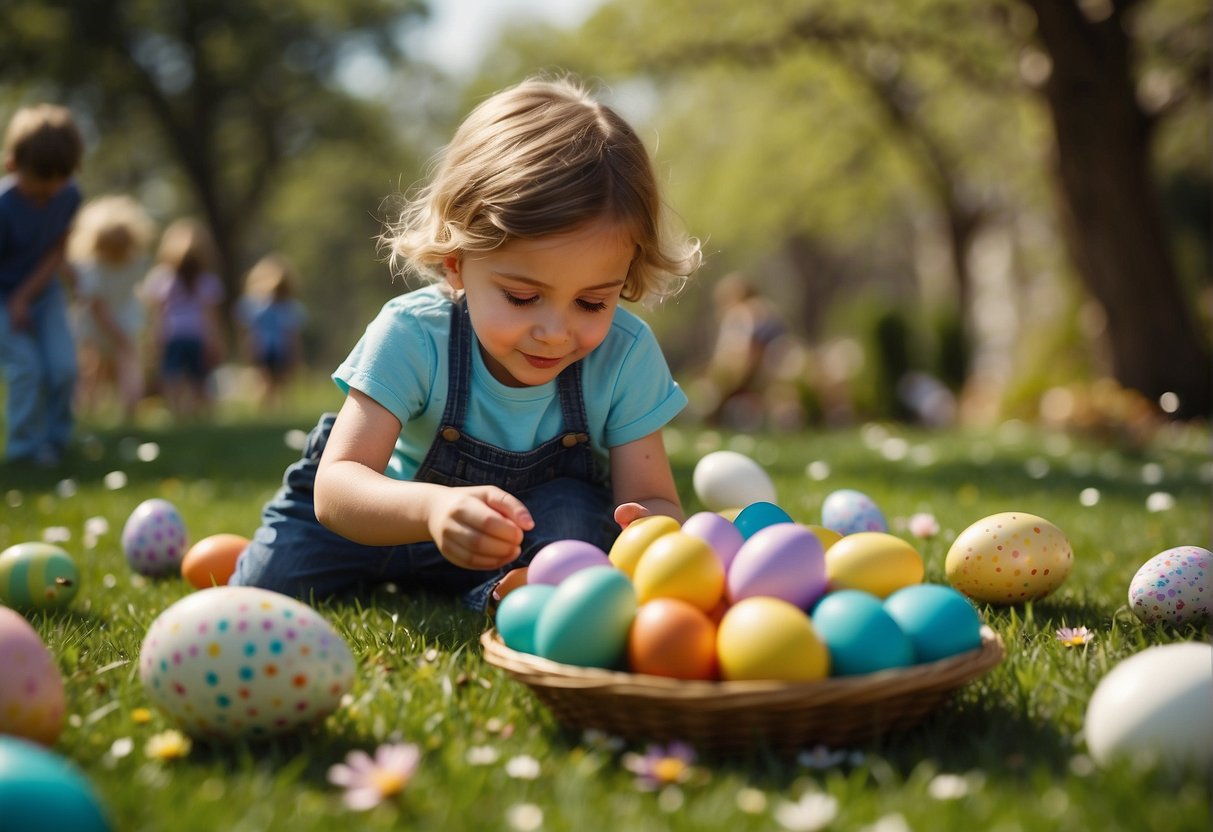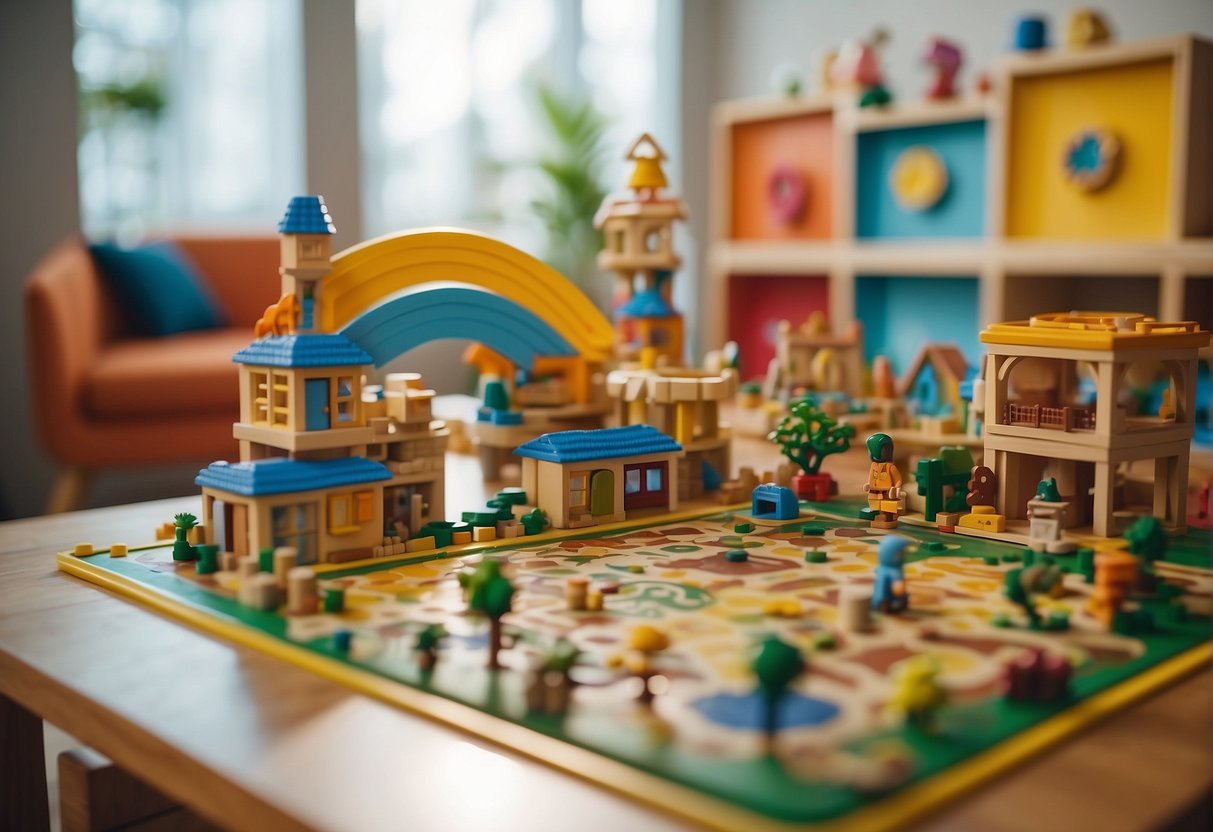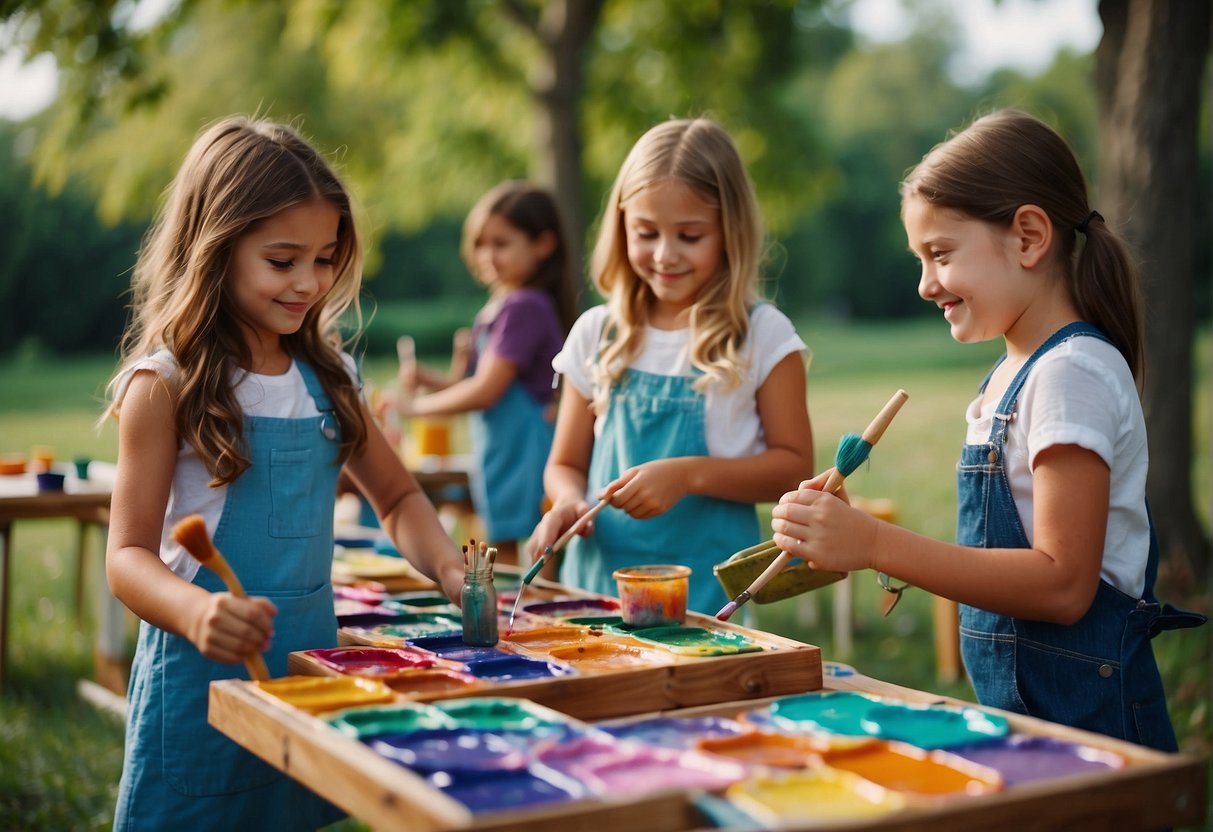Engaging in sand play is a delightful and important aspect of childhood with numerous developmental benefits for kids. Through the manipulation of sand, children develop fine motor skills, engage in creative expression, and learn concepts of texture, volume, and cause and effect. Our focus is to provide parents, educators, and caregivers with a variety of sand play activities that can be easily set up and enjoyed, catering to a range of ages and interests.

We understand that sensory play is integral to early childhood development, and sand is an excellent medium for this type of exploration. Whether it is through building castles, digging for treasures, or making simple sand art, these activities foster an environment for children to unleash their imagination while enhancing their tactile experiences. We have gathered ideas that range from simple to more complex, ensuring that there is something for every child to enjoy.
Our aim is to offer engaging activities that not only entertain but also support developmental milestones through play. By integrating elements such as color, tools, and various techniques, we can create educational and fun sand play experiences. This allows for an adaptable playtime environment, whether indoors with kinetic sand or outdoors in a sandbox, adapting to different settings and seasons.
Fundamentals of Sand Play
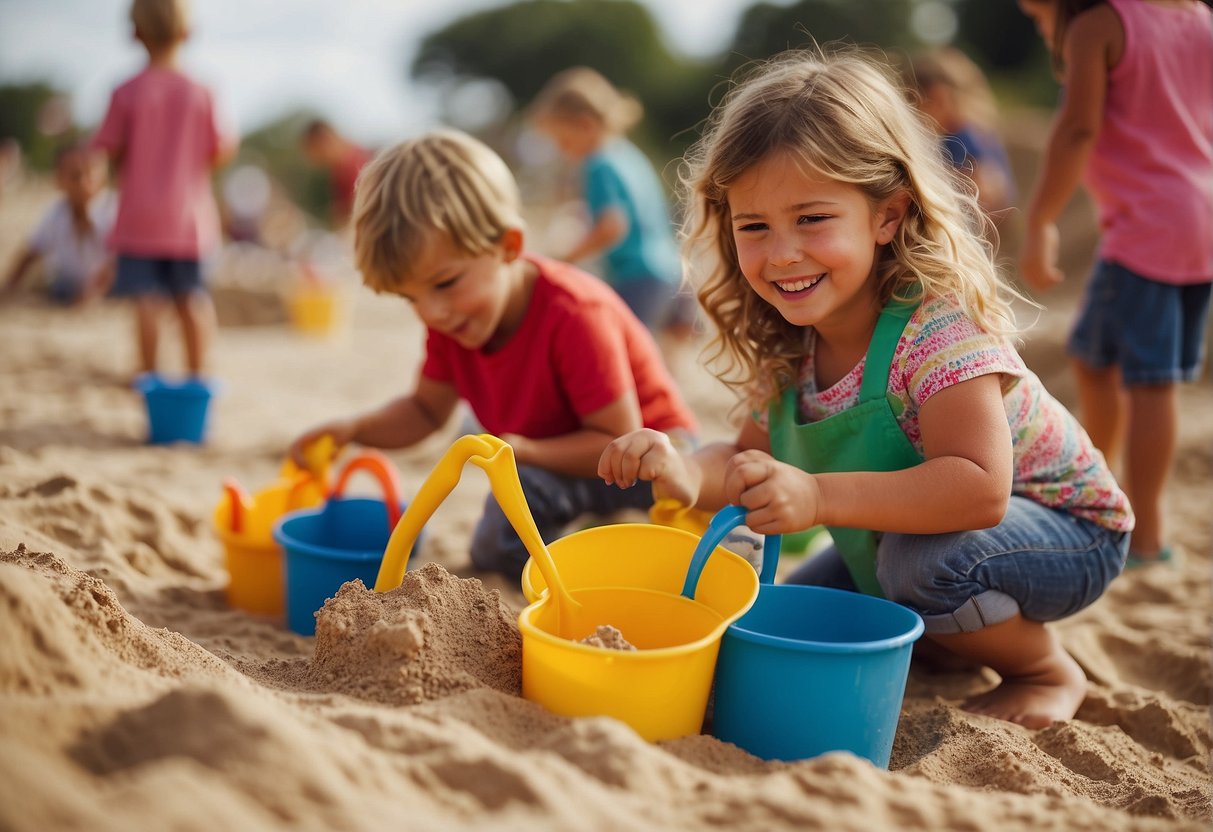
Sand play is a vital aspect of sensory play that engages children’s tactile senses while promoting sensory development. We recognize its importance and integrate it into learning environments through various sand activities. These tactile experiences with different textures and consistencies are crucial for children’s growth.
When setting up a sensory bin filled with sand, we ensure it is both accessible and safe. This controlled environment allows children to explore and learn naturally. Our sand play activities often aim to develop fine motor skills; using tools like shovels, rakes, and molds encourages the coordination of small muscle movements.
We design these activities to be open-ended, allowing children the freedom to create and experiment. For instance, in crafting sand art bottles, we provide colorful layers of sand to create a visual and fine motor exercise. Similarly, writing in sand trays aids in literacy development by connecting the tactile and visual senses.
To enhance the sensory experience, we might incorporate items like water into the sand. This combination introduces a new sensory element, further enriching the sensory play. Such activities are not only about touch; they’re also opportunities for us to facilitate discussions about the sensory observations the children make, deepening their understanding of the world around them.
In our approach to sand play, we always prioritize the developmental benefits while ensuring children are engaged and having fun. We provide a range of sensory activities directly related to sand, understanding its ability to act as a tool for creative, educational, and sensory-rich experiences.
Types of Play Sand
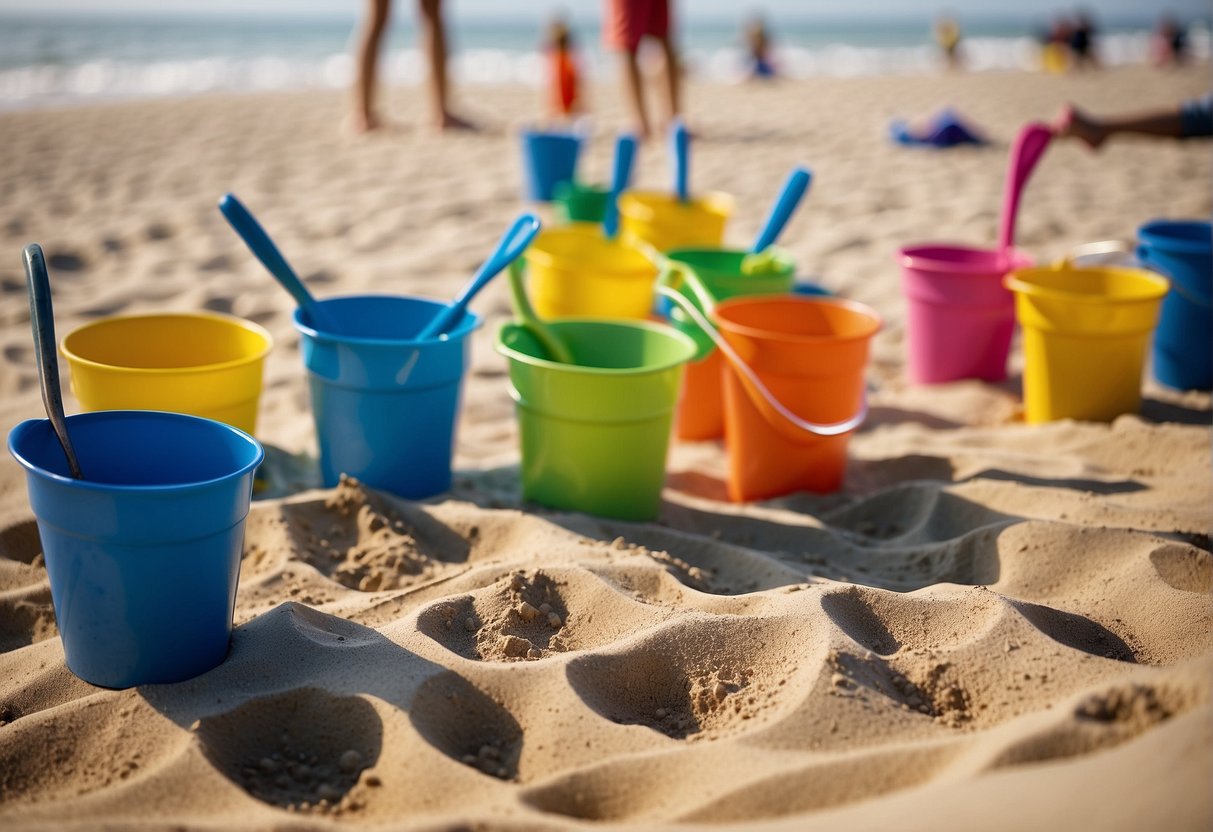
When we explore the world of play sand, we cater to a variety of sensory experiences that kids love. From the feel of the grains between their fingers to the vibrant colors that spark creativity, each type of sand offers a unique play opportunity. Below we’ll discuss some popular types of play sand that are engaging and safe for children.
Kinetic Sand
Kinetic sand is a unique type of play sand that is perfect for molding and shaping. It holds its shape well, thanks to a combination of fine sand and silicone oil. This gives it a semi-solid state that is fascinating for little hands to explore. A sensory bin filled with kinetic sand can provide hours of creative play and is an excellent tool for developing fine motor skills.
Colored and Edible Sand
Colored sand introduces a visual element to sand play, making it even more stimulating for children. It can be used for art projects, such as sand drawing or layered sand bottles. On the other hand, edible sand, typically made from food-grade ingredients, ensures safe play even for the littlest ones who may be tempted to taste their play materials. Edible sand can be homemade or purchased and is ideal for activities like ‘sandbox cooking’ or sensory bins.
Homemade Moon Sand
You can easily create moon sand with items from around the house. This DIY version of kinetic sand typically includes a mix of sand, cornstarch, and water, and sometimes oil to achieve a moldable texture. Our DIY kinetic sand is less sticky and more crumbly compared to the commercial one, making it a fun and educational homemade project.
Commercial Play Sands
Commercial play sands are specifically designed for safe play. They are usually pre-washed and smoothed to remove any harmful particles that can pose a risk during play. This type of play sand is often found in playground sandboxes and is ideal for large-scale outdoor sand activities. It’s worth noting that some may contain crystalline silica, so it’s important to choose a dust-free, non-toxic brand for children’s play areas to ensure safety.
Creative Sand Activities
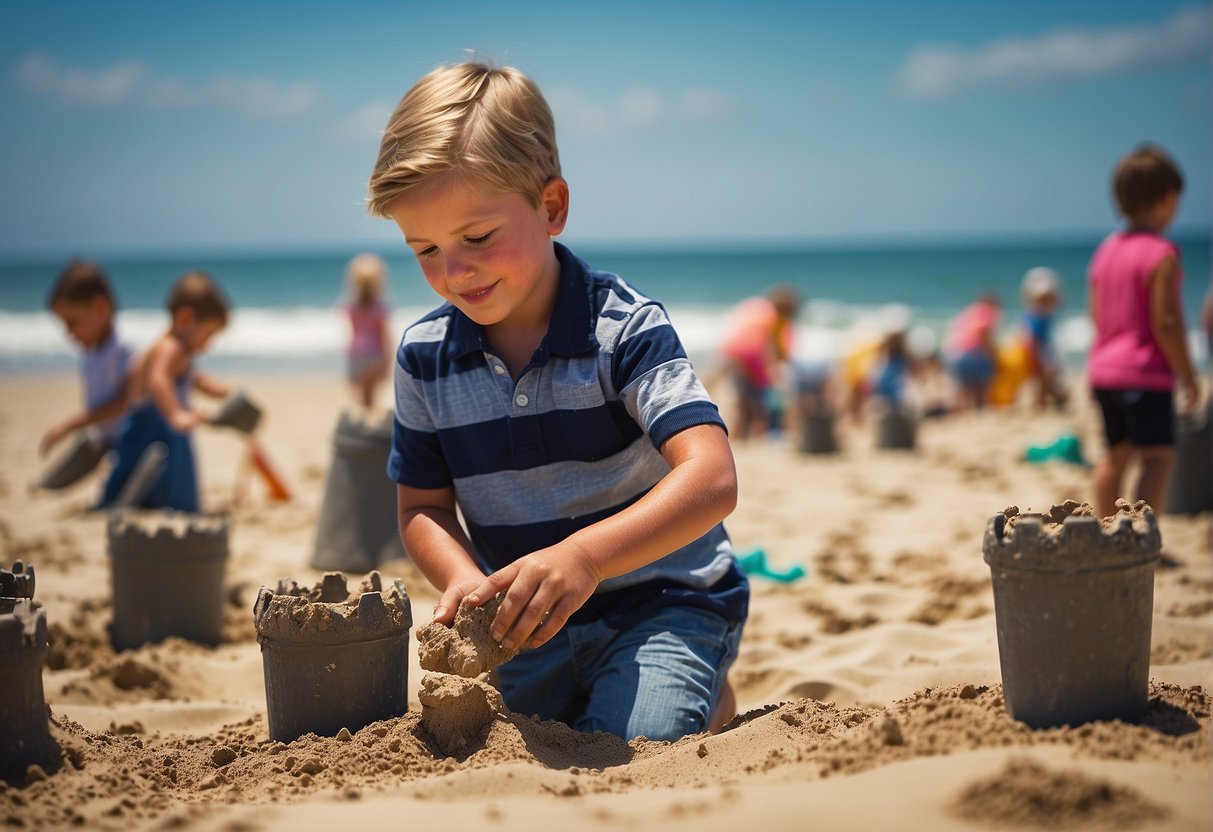
We understand the importance of sensory play in a child’s development, and sand provides a versatile medium for a wide array of creative activities. Engaging in these activities can significantly enhance a child’s creativity and imagination through tactile experiences. Here, we outline some distinctive ways to utilize sand for creative play.
Building Sand Castles
Building sand castles is a classic exercise in creativity and problem-solving. We recommend starting with damp sand for better moldability. Providing buckets, shovels, and various molds can aid in constructing elaborate structures.
-
Steps:
- Gather damp sand in a bucket.
- Overturn the bucket to create the base shape.
- Carve out doors and windows using sticks or shovels.
-
Tips:
- Compacting sand makes it easier to shape.
- Use a spray bottle to keep sand moist.
Making Sand Art
Sand art allows children to experiment with colors and textures. Using different shades of colored sand and clear containers, we can layer sand to create visually appealing patterns.
- Materials:
- Colored sand
- Clear bottles or containers
- Funnels and scoops
To make your own colored sand:
- Mix sand with powdered tempera paint.
- Spread it out to dry before layering in a container.
Crafting with Sand Slime
Sand slime combines the enjoyment of slime with the gritty texture of sand, creating a unique sensory experience. Use a basic slime recipe and incorporate sand for added texture.
- Recipe:
- Combine clear glue with liquid starch and mix.
- Gradually add fine sand until desired consistency is reached.
- Knead the mixture well.
Children can stretch, pull, and mold the slime, which promotes sensory play and imaginative creation.
Creating with Loose Parts
Integrating loose parts with sand play can spark a higher level of creativity. Loose parts – such as pebbles, sticks, leaves, and shells – encourage imagination as children invent new ways to use them.
- Ideas for play:
- Create patterns or mandalas using natural items and sand as the canvas.
- Bury objects in the sand for a treasure hunt activity.
By incorporating loose parts into sand exploration, children learn about textures and colors while developing their fine motor skills.
Educational Sand Activities

Incorporating sand into learning activities enhances sensory experiences and helps solidify concepts for young minds. We focus on literacy, math, and science, utilizing sand’s tactile nature to foster educational growth.
Literacy and Writing
We initiate literacy and writing in the sand by encouraging children to trace letters and numbers, enhancing their motor skills and letter recognition. Literacy Sand Station involves burying laminated letters in sand and having children unearth and match them to a corresponding worksheet. Additionally, Writing in Sand allows them to practice penmanship by writing words directly in the sand, connecting the physical sensation with the visual representation of their writing.
Math and Problem Solving
For math, sand offers a practical way to visualize and solve problems. Counting with Shells is a simple exercise where children count and sort seashells or other items hidden in the sand, learning number recognition and counting skills. Introducing Sand Math Games, such as creating shapes or patterns with natural materials, strengthens understanding of geometry and spatial awareness, as well as fosters problem-solving skills.
Science and Sensory Exploration
Sand is a versatile medium for science exploration. Layered Sand Art teaches about sedimentation and the formation of layers in the earth. By using different colors of sand, children can understand how sedimentary rocks are formed. Water Flow Experiments in the sandpit demonstrate erosion and the effects of water on landscapes, linking sensory play with scientific concepts. These activities not only feed children’s innate curiosity about the natural world but also underpin foundational science knowledge.
Sand Play for Different Ages
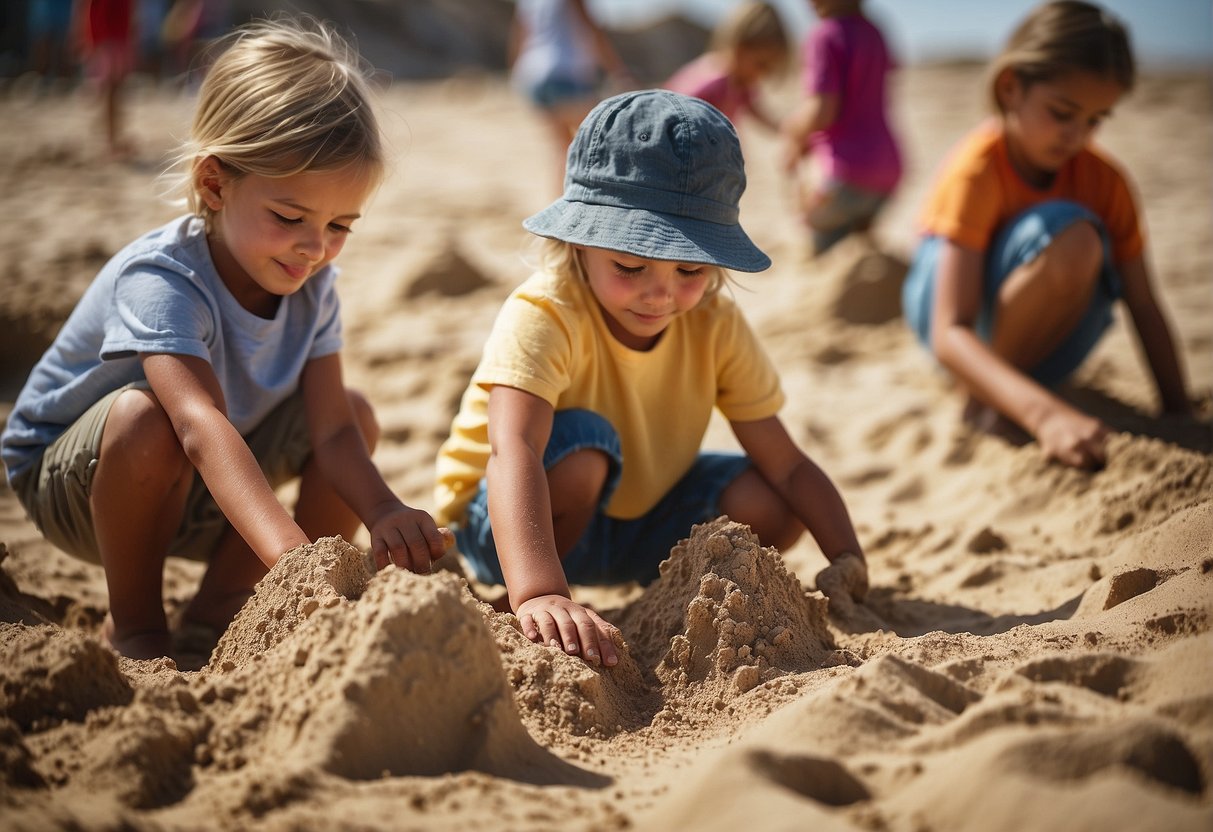
Sand play offers a diverse range of learning through play experiences tailored to different developmental stages. We’ll explore activities suited to toddlers, preschoolers, and older children, focusing on boosting social skills and cognitive development.
Toddlers
For toddlers, sand play is often about exploring textures and simple actions. We recommend:
- Sensory Exploration: Let toddlers feel the sand, run it through their fingers, and learn to scoop and pour. This promotes fine motor skills and sensory awareness.
- Simple Molds: Use cups or basic shapes to help toddlers create and demolish small sand structures, enhancing their understanding of cause and effect.
Preschoolers
Preschoolers are ready for more structured activities, and sand play can be very instrumental in learning:
- Themed Play: Encourage preschoolers to engage in themed sandpit play, such as creating a small town, which fosters imaginative role-playing and social collaboration.
- Learning Shapes: Use sand to trace shapes and letters or create shape impressions, which aids in letter recognition and prepares them for writing.
Older Children
Older children can handle complex tasks and enjoy challenges in their sand activities:
- Building Projects: Challenge them to construct elaborate sandcastles or sculptures, which requires planning and problem-solving skills.
- Archaeological Digs: Simulate an archaeological dig by burying objects in the sand for them to discover, inspiring curiosity and teaching patience and focus.
Incorporating Nature and Sensory Elements
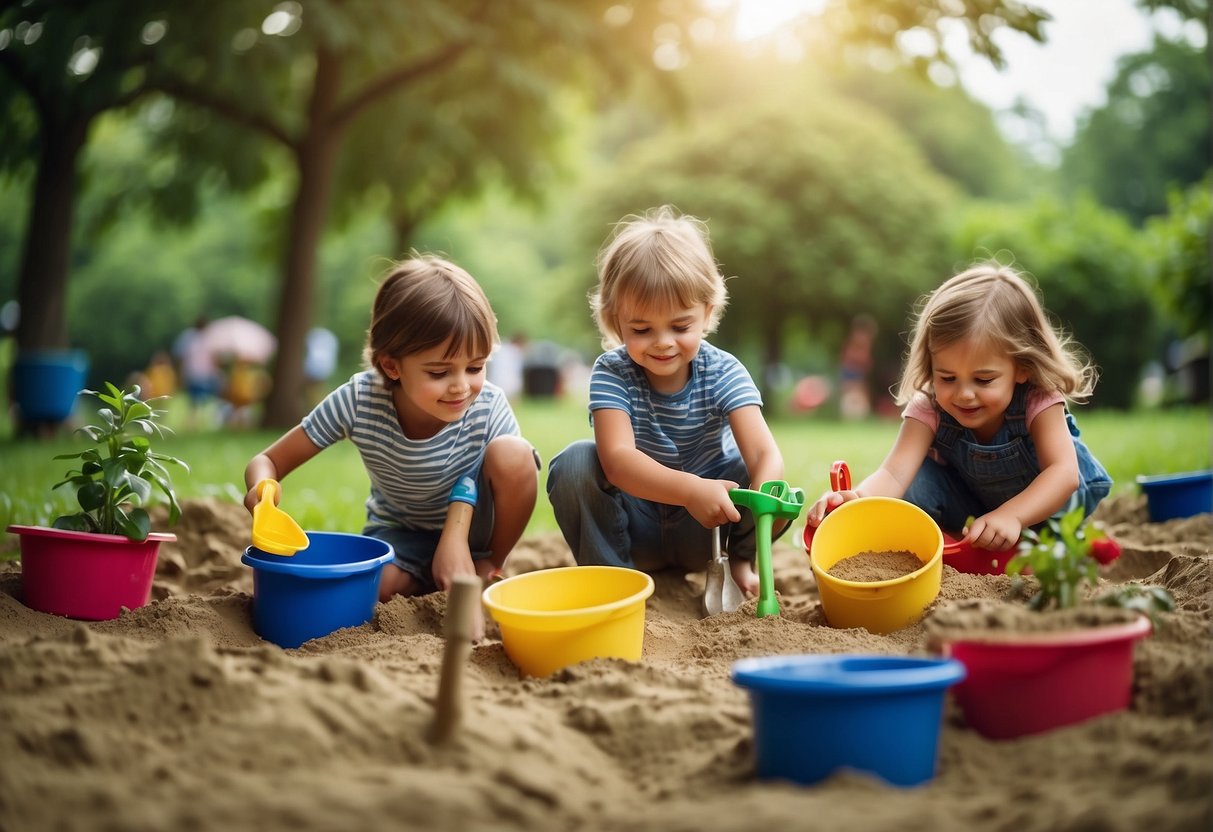
In our approach to sand play, we enhance the tactile experience by incorporating elements from nature, encouraging exploration of textures and patterns. Let’s guide children through a multisensory journey that both stimulates their senses and fosters an appreciation for the environment.
Using Natural Materials
We can elevate sand play by introducing natural materials that children might find on a nature walk. For instance, gather sea shells of various sizes and shapes, smooth stones, and even twigs or leaves. Place these items in the sand and encourage children to bury and then excavate them, akin to a little archaeologist. Not only does this activity sharpen their fine motor skills, but it also subtly teaches about nature’s diversity.
- Items to Embed in Sand:
- Sea shells
- Stones
- Leaves
- Twigs
- Pinecones
Exploring Textures and Patterns
We focus on enriching children’s sensory vocabulary by experimenting with textures and patterns in sand. Invite the kids to press different materials into the sand to create imprints. For example, we can use the ridges from sea shells to make intricate patterns or have small toys leave their tracks in the sand. By dragging sticks or stones across the surface, children can explore straight or wavy lines, enhancing their understanding of spatial relationships and artistic expression.
- Sensory Exploration Activities:
- Pressing shells into sand to create textures
- Drawing lines with sticks or stones
- Making tracks with toys
- Creating patterns with leaves
We engage kids not just in play but in a sensory learning journey outside that combines the rich texture of sand with the wonders of nature.
Theme-Based Sand Activities
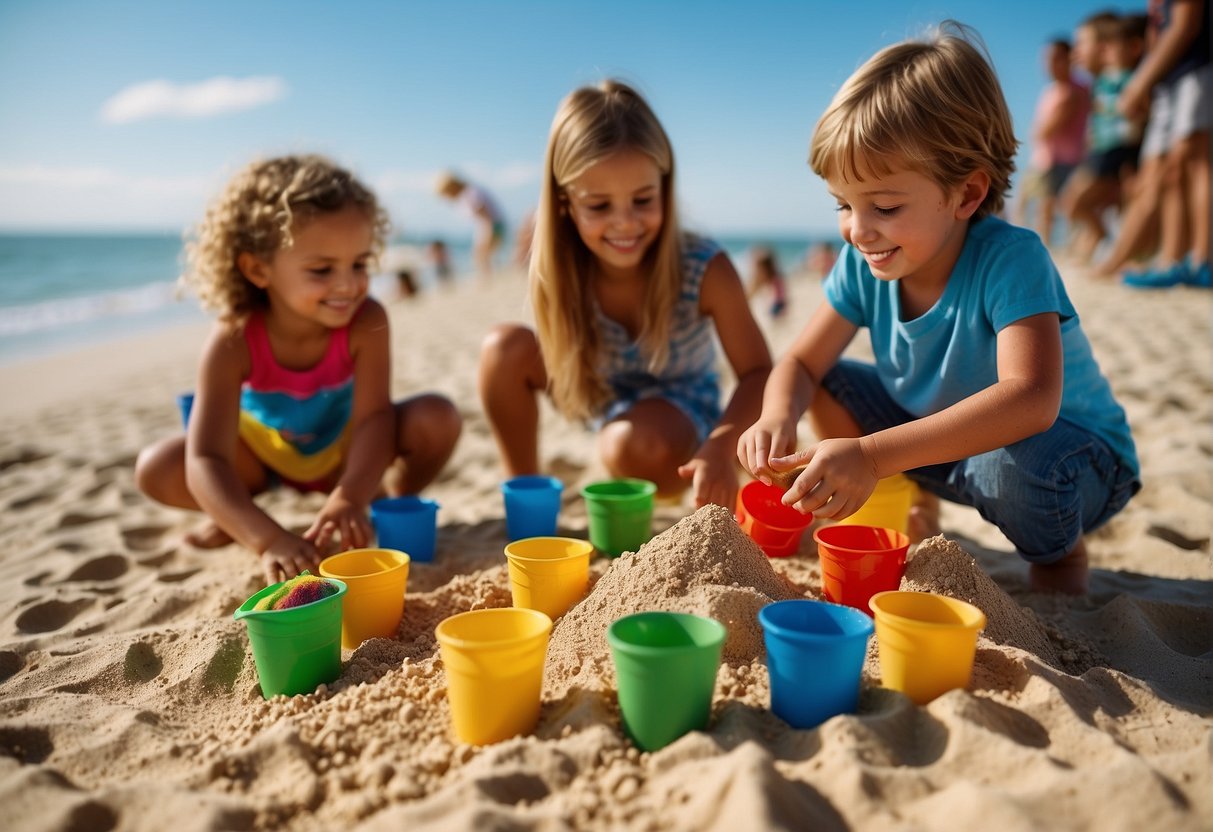
When we introduce theme-based activities, we’re harnessing the power of imagination and education through a tactile and engaging medium. Every theme offers a unique adventure, allowing children to discover new worlds right within the sandbox. Let’s explore some captivating themed activities that are both enjoyable and enriching for kids.
Ocean Sensory Bin
In our Ocean Sensory Bin, we create a mini seaside haven using a variety of materials. Fill a large container with sand to mimic the ocean floor and add elements such as:
- Water: Add blue food coloring to a section to resemble the sea.
- Sea Creatures: Plastic fish, starfish, and crustaceans enhance the bin’s authenticity.
- Seashells: Scatter various shells throughout for added texture and discovery.
Children can dive into an oceanic expedition, feeling the cool pretend water, digging for shells, and learning about marine life.
Dinosaur Excavation
Our Dinosaur Excavation turns the sandbox into a prehistoric dig site. To create this activity:
- Bury dinosaur bones or plastic dinosaurs in the sand.
- Provide tools like brushes and shovels for excavation.
- Kids can unearth these ancient treasures, identifying the different types of dinosaurs they discover.
It’s an excellent way for children to engage with history and science, imagining themselves as paleontologists on a grand adventure.
Holiday-Themed Creations
Throughout the year, we can celebrate different seasons and holidays with Holiday-Themed Creations in the sand. For instance:
- Thanksgiving: Mold a sand volcano to resemble a bountiful harvest.
- Christmas: Shape sand into holiday figures like snowmen or Christmas trees.
- Easter: Hide colorful plastic eggs in the sand for a sandbox egg hunt.
By doing this, children learn about various traditions while expressing their creativity in a festive and seasonal context.
DIY Sand Activity Resources
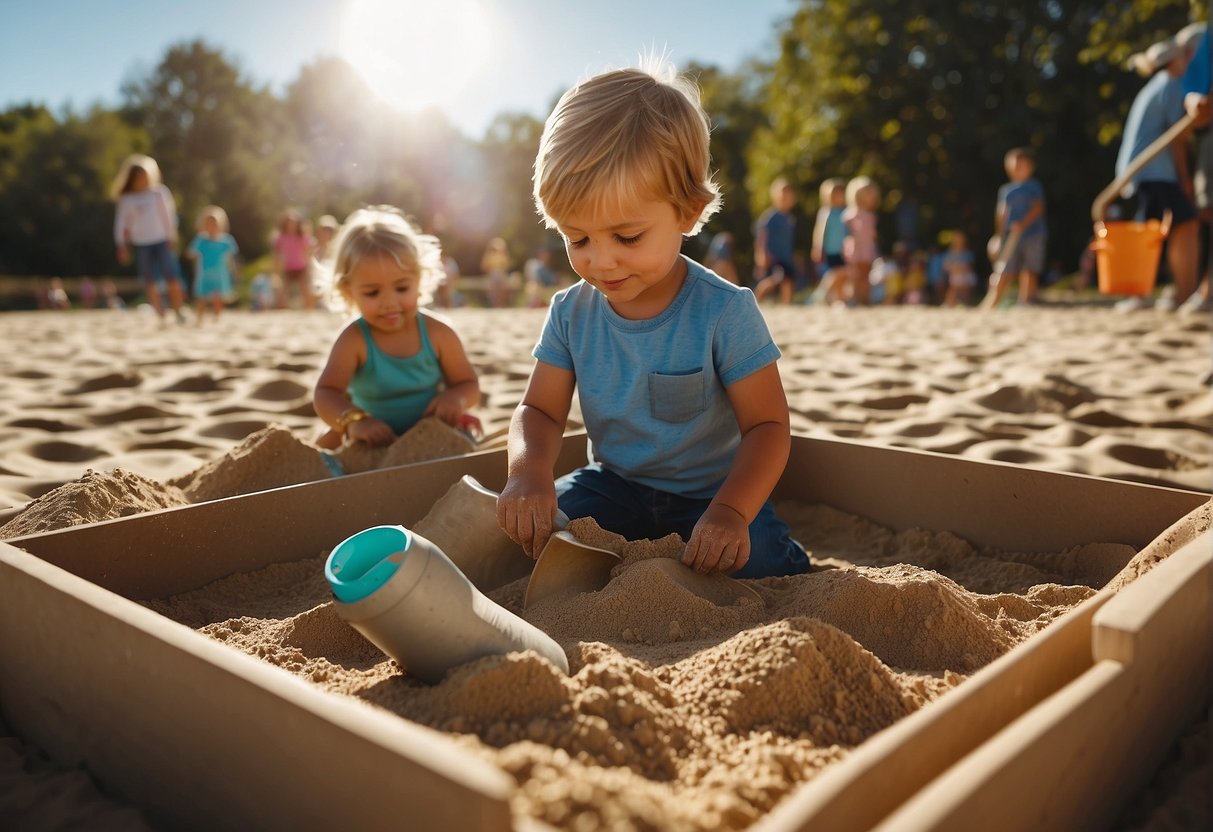
In our exploration of sand activities for children, we offer resources for creating unique sensory experiences right at home. These activities nurture creativity and provide hands-on learning opportunities with simple ingredients.
Homemade Sand Slime Recipes
To craft homemade sand slime, we need a blend of sand, school glue, and a slime activator like liquid starch or borax. Here’s a basic recipe to start:
- Mix 1 part fine sand with 2 parts school glue in a bowl.
- Gradually add the slime activator until the mixture reaches the desired consistency.
For more creative variations, platforms like Pinterest abound with ideas, offering countless recipes that incorporate sand and other textures.
Making Your Own Moon Sand
DIY moon sand is another tactile adventure with just a few ingredients. To make your own moon sand at home, follow this simple recipe:
- 8 cups of flour
- 1 cup of baby oil
- Thoroughly mix the flour and baby oil in a large container until combined.
- The result should be moldable and soft, yet crumble like wet sand.
Moon sand aficionados often share their DIY successes on Pinterest, providing a wealth of personalized recipes and coloring tips.
Safety and Clean-Up Tips
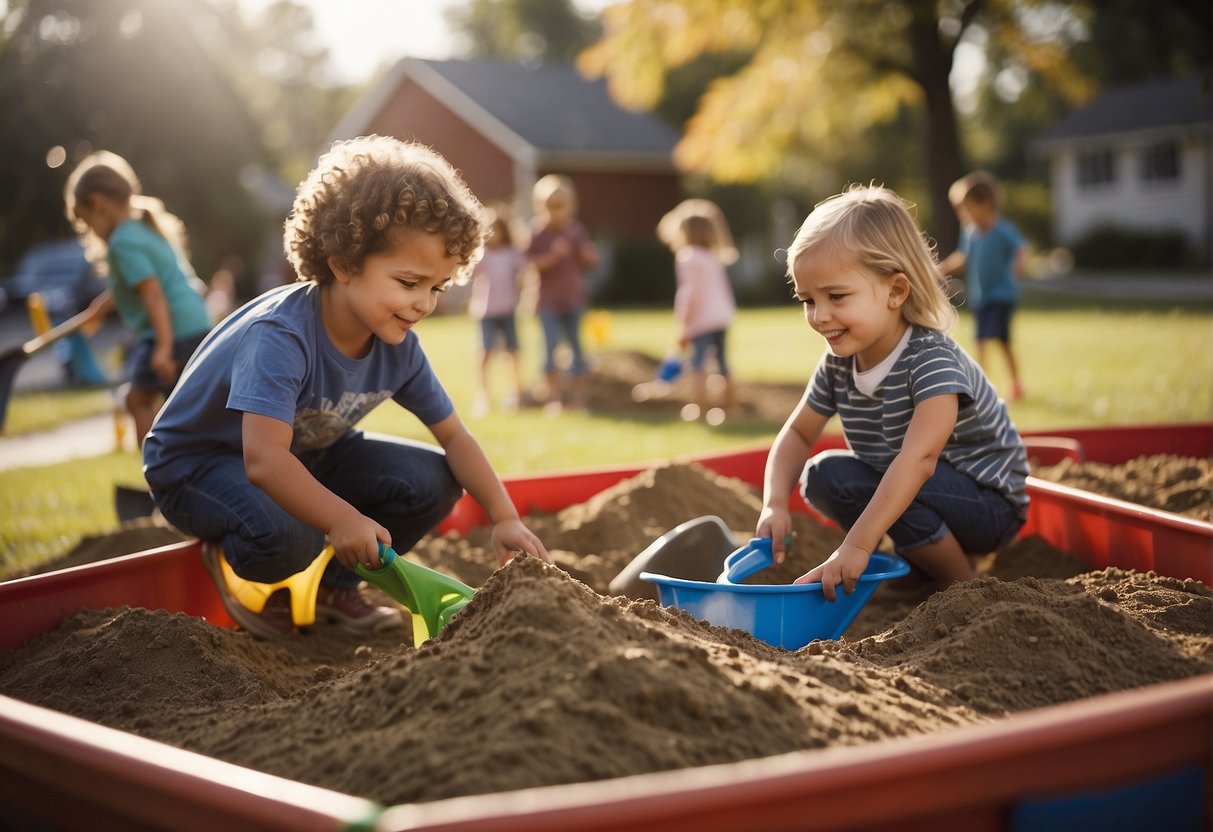
When engaging children in sand play activities, we place a high priority on safety and cleanliness. Safety is paramount; we always ensure that the sand used is non-toxic and free from harmful substances. For indoor sand play, we protect our surfaces with plastic tablecloths or newspapers to prevent sand from becoming embedded in carpets or hard-to-clean spaces.
For cleanup, we utilize several strategies to maintain a tidy workspace:
- Preparation is Key: Before any sand activity, we set up a cleanup station complete with wipes, a brush and dustpan, or a small vacuum for swift action post-play.
- Containment Measures: We advise using a sand tray or baby pool to contain the sand, making it easier to manage and clean.
| Clean-Up Supplies | Purpose |
|---|---|
| Wipes | Clean hands and spilled sand quickly |
| Brush and Dustpan | Gather loose sand on surfaces |
| Small Vacuum | Remove sand grains from fabrics |
- Regular Maintenance: We recommend regularly sifting through the sand to remove debris and replacing it as needed to uphold cleanliness and safety. Always supervise children during sand play to ensure they don’t ingest sand or put it in their eyes.
By following these guidelines, we can provide a safe and enjoyable sand play experience for children while keeping our space clean and orderly.
Supplementary Activities and Equipment
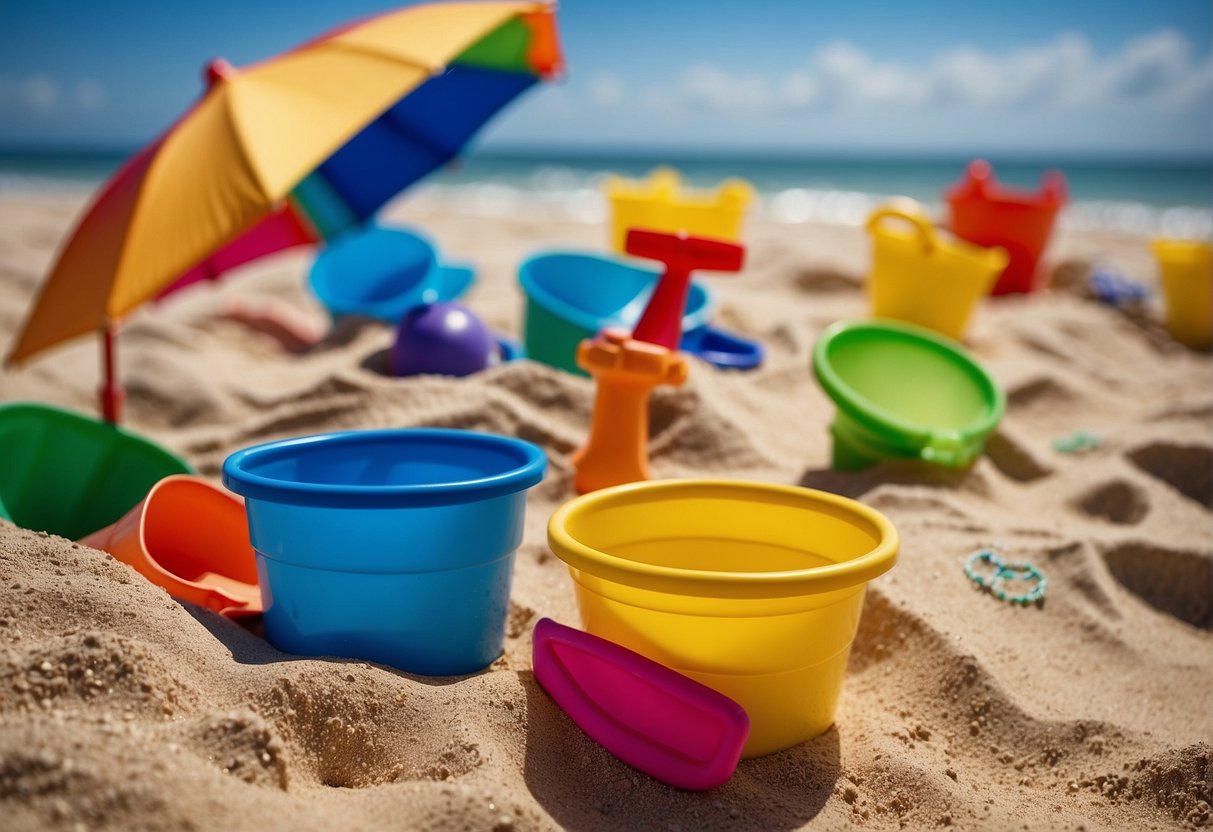
To enrich the traditional sand play experience, we can integrate additional elements that both challenge and engage children. We’ll explore practical ideas to merge sand with water, storytelling, art, and toys that can be easily implemented.
Combining Sand and Water Play
Incorporating water into sand play opens up a new dimension of sensory experiences. By using a sand table or a DIY water and sand setup, children can experiment with the changing textures and properties of wet sand. With materials like scoops, funnels, and toy boats, the interaction between water and sand can facilitate a foundational understanding of basic scientific concepts such as buoyancy and filtration.
Including Books and Storytelling
Books that feature stories about beaches, deserts, or construction themes can be marvelous tools to pair with sand play activities. While reading, we can introduce figurines to retell the narratives, allowing kids to reconstruct scenes in the sand. Storytelling through sand play not only enhances literacy skills but also encourages children to create their own imaginative worlds.
Using Sand in Art Projects
Sand can be an excellent medium for art, fostering creativity and fine motor skills. Melissa & Doug products like the Baking Play Set let little ones craft “sand cookies,” utilizing safe, play-friendly equipment. Moreover, kids can make sand paintings with colored sand or create textured art by mixing sand with paint, providing a tactile dimension to their artistic endeavors.
Adding Play Figures and Vehicles
Introducing play figures and toy cars to the sandbox turns simple sand play into elaborate adventure stories or role-playing games. Children drive the narrative, using the toys to simulate real-world scenarios or invent new ones. This type of play supports the development of social skills, problem-solving, and motor planning as they navigate the textured terrain.
By adopting these supplementary activities and equipment, we can substantially enhance the traditional sand play experience, fostering development across cognitive, physical, and creative domains.
Maximizing the Benefits of Sand Play
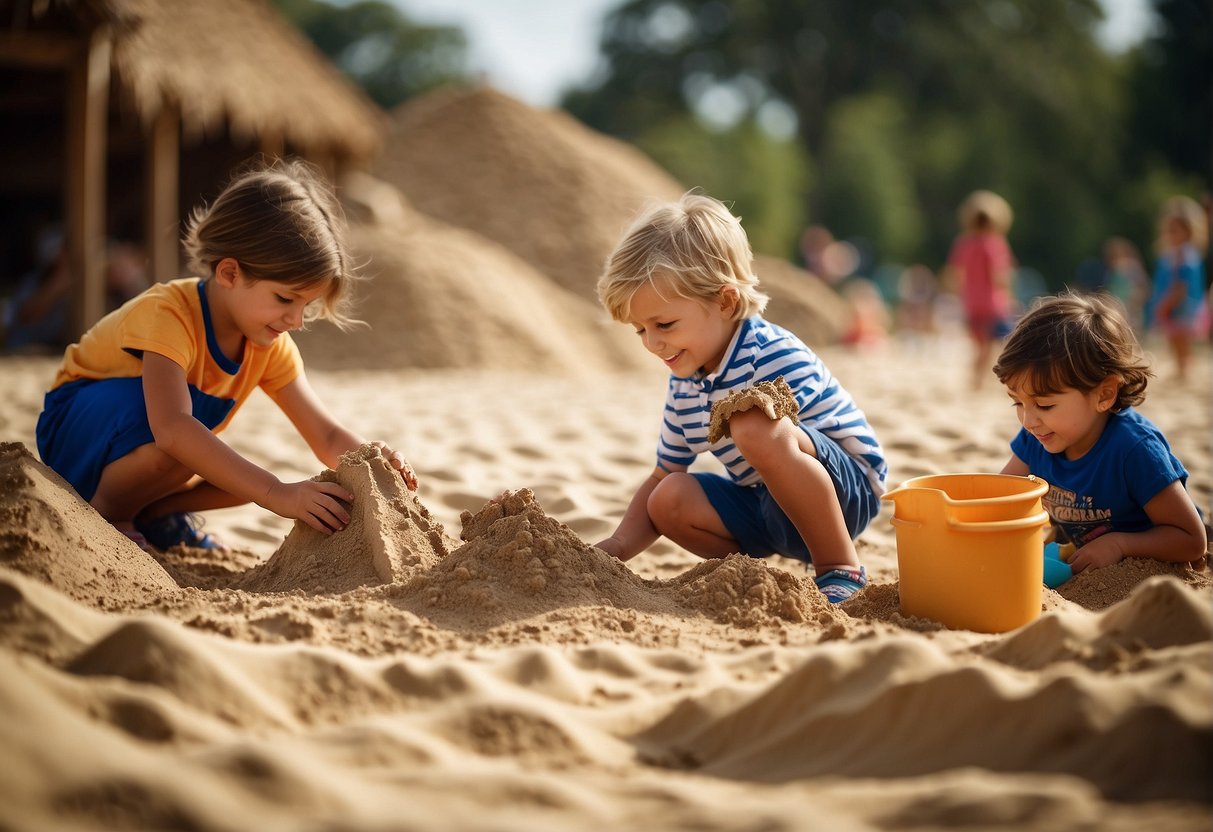
In our experience with child development, we’ve observed that sand play can be incredibly beneficial. We aim to enhance those benefits through structured playtime activities. Here’s how we can achieve that:
Encouraging creativity and imagination:
- Sensory Bins: By integrating a variety of materials such as feathers or beads into sand, we stimulate imaginative play. Children can construct narratives or engage in pretend play, improving their creative thinking.
- Sand Sculptures: Constructing various shapes promotes problem-solving as children figure out how to make structures stand.
Promoting sensory development:
- Texture Exploration: Mixing different elements like water or dry pasta changes the texture of the sand, offering diverse tactile experiences.
- Temperature Variation: Playing with warm or cool sand can help children understand and adapt to different sensations.
Improving social skills:
- Group Projects: By participating in joint activities like building a large castle or a town, children learn to communicate, share, and collaborate.
- Role-Playing: When kids engage in themed play (e.g., running a bakery with sand “dough”), they practice verbal skills and empathy.
Table 1: Sand Play Activities and Their Benefits
| Activity | Benefits |
|---|---|
| Sensory bins with varied materials | Boosts imagination and tactile exploration |
| Creating sand sculptures | Develops creative thinking and problem-solving |
| Mixing textures | Enhances sensory awareness |
| Temperature play | Encourages adaptability to environments |
| Collaborative construction | Fosters teamwork and social engagement |
| Thematic role-playing | Improves communication and role-taking abilities |
We focus on these simple yet effective methods to enrich the play experience and provide children with a robust set of benefits that contribute to their growth.
Ideas and Inspiration Sources

When we seek inspiration for sand play activities for kids, a blend of creativity and educational insights forms our guide. We scour various platforms and integrate activities that not only amuse but also contribute to children’s sensory and cognitive development.
Online Platforms:
- Pinterest: A treasure trove of pinboards makes it an ideal spot to find visually driven ideas for sand crafts and play setups.
- Education Blogs: These are rich with step-by-step guides and thematic play ideas.
In the Classroom:
We adapt activities for group engagement, fostering skills such as collaboration and sharing among kids.
Craft-Based Play:
Our aim is to introduce crafts that encourage fine motor skills and artistic expression. Simple resources yield engaging outcomes.
| Activity Type | Source of Inspiration |
|---|---|
| Sensory Play | Education blogs & Pinterest |
| Crafts | DIY tutorials & Craft blogs |
| Educational | Classroom experiences |
We ensure that our selected activities are diverse, catering to different ages and abilities, making sure they are inclusive and educational. Whether it’s creating sand dough or drawing with colored sand, we encourage imagination and tactile learning through our curated selection.
- 15 Football-Themed Snack Ideas for Kids & Teens - September 9, 2024
- 15 Mistake Quotes For Kids - September 7, 2024
- Fun Shark Quotes and Sayings For Kids - September 7, 2024





